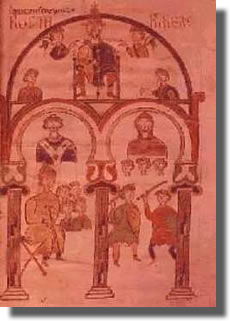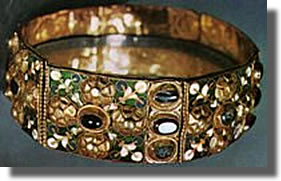Scientific Area » Longobard Culture » Law
« Back
THE WRITTEN LAW
Over 6th and 7th centuries the Roman law was enriched with the Germanic law of people come from outside with their quite different mentality. In Italy the Longobard law left long-lasting traces: it was indeed in juridical and administrative respects that the Longobard nationalist character still made its voice heard.
Before the arrival in Italy the Longobard law was customary, unwritten and orally handed down. As long as the people dwelled in a narrow land the assembly had confirmed, cleared up and explained its own laws. In Italy instead, the dispersion of the gentes in a vast land prevented such customary law from being enforced.

Miniature on Edict of Rothari
Thus, in 643 the Edict of Rothari (636-652) was issued, which was the first written law of the Longobard kingdom. Although it was specifically addressed to the Longobards, it was drawn up in Latin but with many Longobard words, as to entries and morphology (e.g.: amund, angargathungi, fulcfree, gairethinx, grabworfin, launegild, marthworfin, rairaub, wecworin).
On the one hand the Edict reconfirmed the rules, still alive in traditions, of the old Longobard customary law, on the other bore witness to the cultural development of that people.
Rothari’s protection of land private property proved the development of the Longobard economy after the arrival in Italy. When Rothari issued his Edict, agriculture in the Longobard society was almost acquired and consolidated, which was the outright origin of private property.

The Edict assured subjects, particularly the lowest social classes which provided most of the soldiers, that those rules would guarantee their rights against all forms of arrogance.
The Edict gave rise to a legislative trend promoted by Grimoald (662-671), Liutprand and Ratchis (744-749; 756-757): such genesis of the Longobard national law was the true origin of their storiography.
The Edict kept its popularity over time to the point that in the town of Monte Sant'Angelo a monument, presumibly a baptistery, was dedicated to Rothari under the name of “Tomba di Rotari”.
« Back


